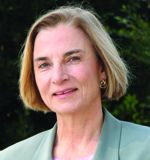May 2014

Patricia W. Finn, MD
During my presidential year, I have worked closely with ATS members and staff to embed health equality in everything the ATS does to create a sustainable model. This year, presidential benchmarks charged all ATS committees with defining and addressing health equality. Some of their ideas have been quick to implement, and others will take time. The current members of the Executive Committee and upcoming ATS presidents (Drs. Tom Ferkol, Atul Malhotra, and David Gozal) are committed to health equality initiatives.
The Health Equality Subcommittee, which is a permanent subcommittee of the Health Policy Committee in the ATS structure, has developed a list of deliverables to help address these issues. First, they are committed to clean air, including education and advocacy against e-cigarette access for children. Second, fostering diversity in the workforce and advocating for Medicaid expansion and implementation of the Affordable Care Act will bring us steps closer to implementing high-quality health care for all. Third, the ATS will publish an annual or semiannual report on lung health in vulnerable populations with the goal of documenting our efforts and pointing out new directions for health equality initiatives.
As immediate past president, I will be relentless in championing health equality and embedding it as a goal share by all ATS leaders. The themes of future presidents, focusing on career development (Dr. Ferkol) or the next generation of professionals in our field (Dr. Malhotra), integrate with health equality.
Service on the Executive Committee is a five-year commitment, and ensuring the success of our replacements is vital. I plan to support the president and Executive Committee wherever I may be most helpful.
The most gratifying and humbling experience over the past year has been meeting and interacting with the unsung heroes who are already working day in and day out in service to the mission of health equality. I raised the topic of health equality over a year ago and tried to think of ways to embed it into the ATS. Instead, I found that health equality is already a sustainable pillar of the ATS. It has been an honor to be a part of this and to learn from our brilliant and devoted members who are already tackling these questions in their everyday lives.
On another note, I have greatly enjoyed participating in Hill Day. As president, I have also been able to serve as a voice for clean air, smoking cessation, regulation of e-cigarettes, and related topics. Whether writing letters to the editors of major newspapers or speaking at meetings of interested groups, it has been a pleasure and fun to advocate on behalf of the ATS.
Engaging the next generation to find our replacements is critical. The message we should be sending is that this is the society that wants to make a big impact, e.g., “Where Today’s Science Meets Tomorrow’s Care.” The Society’s members have integrity of the highest caliber. It is also important that future generations know how much our members care about their success. I have had the pleasure of working with numerous ATS members, all with distinguished careers, who first and foremost think about their own replacements and the next generation. It is not about us, it is about them. We can attract the best new recruits if we show them we have the best science, the best translation to care, and that we care about them and their careers.

